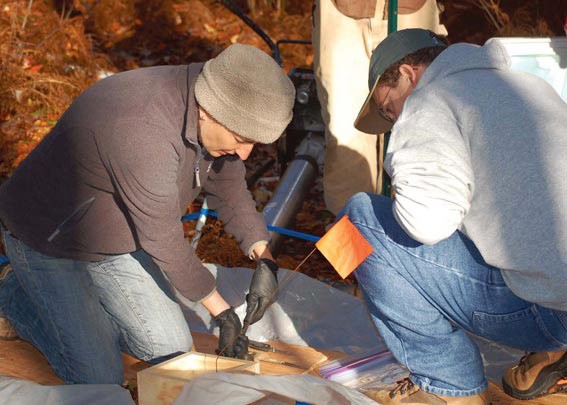Soils throughout the world store more carbon, in the form of organic matter, than all of the vegetation and atmosphere combined. Microorganisms in the soil – bacteria, fungi, protozoa, nematodes, and other organisms – feed on that organic matter and release large quantities of carbon dioxide. Historically, this release of CO2 has been balanced by the photosynthesis of plants, which absorb about the same amount of CO2 as the soils release. But according to a study by University of New Hampshire Professor Serita Frey, as global temperatures rise, additional carbon is released from soils into the atmosphere – at least in the short term.
“While they’re low on the charisma scale, soil microorganisms are critically important to the carbon balance of the atmosphere,” said Frey. “If we warm the soil due to climate warming, are we going to fundamentally alter the flux of carbon into the atmosphere in a way that is going to feed back to enhance climate change?”
Frey and colleagues at the University of California-Davis and the Marine Biological Laboratory simulated the effects of climate change on the soil by placing heating cables 10 centimeters beneath the soil surface at study plots in the Harvard Forest in Petersham, Massachusetts, to learn how a warming world would influence what takes place in the soil. The study plots, one heated for two years to simulate short-term warming and another heated for 18 years, were warmed to 5°C above ambient temperature. The project was designed to measure the efficiency of the soil organisms.
“If an organism takes one molecule of glucose, for example, as a food source, some fraction of that goes to cell maintenance and growth, and some portion of that gets lost to the atmosphere as carbon dioxide,” she explained. “The more efficient the organism is, the more of that food source stays in the cell; the less efficient it is, the more is lost to the atmosphere.”
What they found is that as temperatures in the soil increase, the soil microorganisms become less efficient, releasing more carbon dioxide into the atmosphere. That effect diminishes over time, however. The organisms appeared to become more efficient in the longer term, suggesting that the microbial community becomes acclimated to the warmer soils or the community somehow changes.
“The positive feedback response may not be as strong as we originally predicted,” Frey said. “It could be that different species become more abundant and others less abundant over time. Perhaps there’s also a shift in physiology, an evolutionary adaptation to those conditions. We just don’t know yet.”
The next step will be to conduct a DNA analysis of all the organisms found in the soil to identify the species and see if the community changes as the soil warms. The researchers also plan to conduct laboratory tests of the physiology of the organisms to learn if their metabolism adapts to the warmer conditions.
“Ultimately, we’d like to know how climate change is affecting all of these organisms,” she said.


